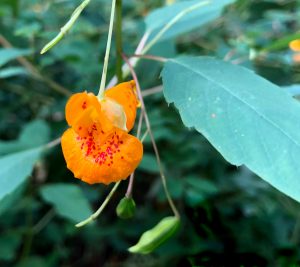We all know jewelweed, especially the kids. It’s that tall orange-flowered weed that has glorious seeds that go SPROING!! when you pinch them, giving it an alternate name of touch-me-not. We notice them mostly in August when they line Marblehead’s Path like crowds at a coronation, but watch closely in May. You’ll see jewelweed just starting to sprout, promising a good crop to come.
Jewelweed is officially named Impatiens capensis. We usually think of impatiens as those bright shade-loving 5-petal flowers from the garden center. Impatiens comes in 2 forms: the multi-petal garden variety and those like jewelweed which have a spur at the back of the flower and what looks like 2 major petals. They look to be very different in shape – but when you buy your next flat of impatiens, turn one of the flowers over and you’ll see a small spur on the back. Now look carefully at a jewelweed flower and notice 5 petals too: 1 large petal above the spur, 2 small petals to the sides, and 1 large petal below – which is really 2 petals fused together as a landing pad for bees.
Why the spur? Some people would say it’s due to Nature’s pure exuberance but there is a very practical purpose for a spur structure. Jewelweed secretes nectar produced high inside the spur, making a pollinator crawl inside to get nectar. The pollinator ends up smearing itself with pollen and carrying that pollen off to the next jewelweed flower. Voila! A high rate of new seed formation! Spurs in different impatiens range from straight to curved, from 0 to 270 degrees. Different pollinators prefer different curvature. Hummingbirds, which are major pollinators, prefer curved spurs. Bumblebees and bees, the other major pollinators, prefer straighter spurs but are not too fussy. Watch a bumblebee when it comes in to feed. It makes the flower bob up and down as though the bee were on a trampoline.
While you are there inspecting how far jewelweed seeds can fly when you pinch them, notice the stems. They are green, almost translucent, and have thickened nodes, kind of like bamboo, where the leaves or branches attach. Jewelweed sap has a long-standing reputation for being useful in reducing poison ivy rash. Its sap is a soapy, mucus-like liquid that has been used since colonial times to treat itching of poison ivy rash, hives, and athlete’s foot. If you accidently brush into some poison ivy, try crushing the stem nodes of jewelweed and rubbing the juice over your skin where poison ivy touched. However, there’s not much clinical proof that this works. While some small-scale studies have shown that jewelweed pulp helps, washing thoroughly with strong soap and water does a better job. Research does confirm that jewelweed will successfully treat athlete’s foot since its sap is antifungal.
Moist, shady areas are favorite jewelweed hangouts, but they will live in full sun, although a bit stunted and bleached-looking. They grow fast and spread very efficiently but they are easy to weed out. Jewelweed could almost be considered the perfect plant neighbor, except that jewelweed is very happy to stand cheek-by-jowl with its neighboring jewelweed, shading out shorter plants.
So when it is August, with a full crowd of jewelweed lining the Path, stop for a moment to sproing! the seeds and start a new generation of jewelweed.

